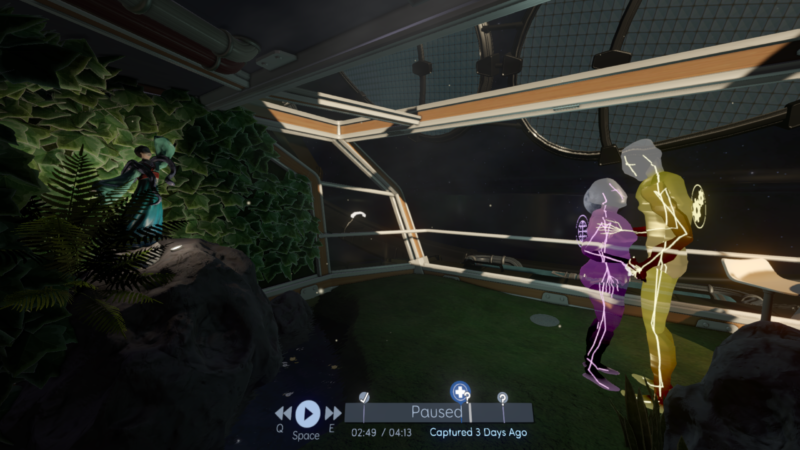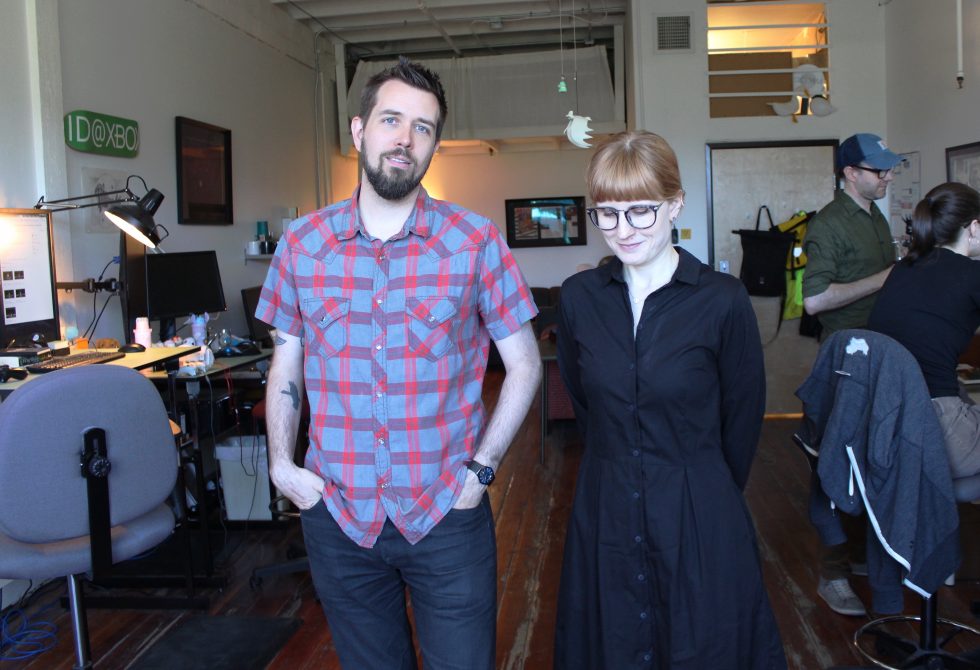
PORTLAND—At most offices, the employees don't take kindly to a stranger rifling through their personal and professional effects. But most offices aren't Fullbright.
You may best know this game-development studio as the makers of Gone Home, the 2013 video game that ushered in a new era of "interactive narrative" hits. Gone Home focused on characters and plot, not action and puzzles, as its audience slowly uncovered a mysterious—and personal—story through found objects. Delightfully, similar things can be said for the company's follow-up game, Tacoma, out this week on Xbox One and Windows PCs.
I was fortunate enough to be invited into the studio's modest warehouse office space just outside downtown Portland. And between interviews, I busied myself by being a total snoop. I opened up books, flipped through greeting cards, examined toy dioramas, peered at screens, and cataloged entire walls of private notes.
The six employees on hand that day, including studio co-founders and directors Steve Gaynor and Karla Zimonja, didn't complain. I figured they were distracted with work on last-minute tweaks and fixes, but later I realized something else was going on. Gaynor and Zimonja have a long history of littering their games' floors, tables, and cabinets with juicy bits of story. Bioshock 2 (and its beloved, weird DLC pack, Minerva's Den) did this with audio diaries and reflective story moments. Gone Home had crumpled letters and secret family discoveries. And now, the studio's triumphant return to form, Tacoma, adds time-shifting and augmented-reality twists to Fullbright's enticing storytelling formula.
This game studio had simply trained me to do what I was doing: to pick through its belongings; to find the stories hidden in the cracks; to replay the past.
Dharma initiative
-
Fullbright's Dharma doll for the Tacoma project.Sam Machkovech
-
Fullbright will not cop to modeling Tacoma after this Star Trek: TNG point-and-click adventure.
-
Found under Steve Gaynor's desk.
-
Found on top of Steve Gaynor's desk.
-
Zimonja admits that this bowl of plastic snakes has quite a bit of odd backstory.
-
Everyone at work at Fullbright.
-
The ceiling-fan decorations, zoomed in.
-
This duck toy appears in Tacoma.
-
An unfolded greeting card on one table.
-
A story about Gone Home's launch, one of many framed clippings.
-
Concept art that made it into Tacoma. It also doubles as hilarious desk art at Fullbright's office.
-
Level designer Nina Freeman has an elaborate collection of deformed Disney toys.
-
Under Tynan's desk.
-
I apologize for the bad photo, but I wanted to point out that Gaynor's desk has a copy of the Star Trek After Dark screensaver in its original box.
-
Gaynor found his signature on this Bioshock 2 collector's edition.
-
The Gone Home special edition, which launched exclusively in Europe. It has long since sold out.
-
The Gone Home collector's edition includes scanned copies of the game's original research notebooks.
The first thing I notice when I poke around Fullbright's office space is a Japanese Dharma doll. It stands near a substantial collection of awards that Gone Home won after its 2013 launch. "When you start on an endeavor, you paint one of its eyes in," Gaynor says. "Then when you accomplish the thing, you get to paint the other eye. This will be at the Tacoma launch party."
When I ask about how long it has taken to get that second eye painted, Zimonja chimes in to say it hasn't been that long—at least, relatively. The doll, after all, is modeled after "a monk who meditated for so long that his arms and legs fell off, and then he looked like that!"
I have played, beaten, and enjoyed Tacoma already, but before explaining why it's a successful story-game, allow me to ink in part of the doll's second eye.
Fullbright measures Tacoma's gestation period in two ways. First, there's the mid-2014 point in which something called Tacoma began production. The original game was set in the Northwestern city of Tacoma, Washington, and the duo describe that version, which was in a pre-production, "gray box" state for about three months, as a "mundane" look at a woman's life in "near-present-day" America.
That game's lead character was "someone who'd lived through the history of a place that had been blue-collar, then went through changes and is now modernizing, like what a lot of the country is going through," Gaynor says. "It seemed like an interesting crossroads of those themes, but as we started building it, it felt too close to what we'd done." (Gaynor suggests that his team's rush to work on something so similar to Gone Home may have come from attracting Tynan Wales, a programmer the duo had worked with during their Bioshock days at 2K Marin. Wales had a career opening and needed to set up shop in a city; Gaynor made an offer to get him to move to Portland.)
As Gaynor tells it, he and his wife were on a scenic vacation—rowing across Crater Lake in Oregon state to hike across Wizard Island, which is possibly the most Pacific Northwest-sounding vacation ever—when he began throwing out ideas for a video game scenario as isolated as the one he was hiking through. Maybe we could set the game on a cruise ship, or even space, he said.
Space: that idea stuck. Or, at least, he convinced Zimonja after the vacation high wore off.
"How can I get reference for a space station?" Zimonja says, her face recalling that 2014 moment's agony. "Tell me that! I'm a concrete thinker. I want to have a basis to build things on. The future? How can we know about it?" Zimonja, after all, began working with Gaynor under a researcher capacity at 2K Marin, where she helped build the worlds and backstories of Bioshock games. Those were never that far from a modern American era. This time, Gaynor assuaged her by saying he wanted to stick to a near-future timeline. ("It's not Star Trek," he quips now. Zimonja immediately replies, "Nor is it the fucking Dune timeline!")
From there, Gaynor, Zimonja, Wales, and environment artist Kate Craig set off to space for about a year's worth of work. Once that year was up, the company had grown to about eight full-time staffers, but it had also taken a major development detour. Perhaps it's no accident that Fullbright's meaning-loaded, one-eyed Dharma doll stands next to a contentious memento: a cover story about the Tacoma that no longer exists.
"We had a big redesign reassessment after the first year of development," Gaynor says. Fullbright had created a "vertical slice" version of Tacoma that lasted approximately 45 minutes, which was handed to select friends and press (including our UK channel). "The reactions we had to it..." Gaynor trails off. "They weren't, they weren't negative! It was generally positive. But people weren't saying the things we wanted them to say about it."Zimonja loudly sighs. "There was just something missing."

Nobody will say it exactly, but it sure sounds like Tacoma was shaping up to be essentially "Gone Home in space." Gaynor admits that Tacoma's first space-station version relied on a nearly note-for-note repeat of the kind of "story breadcrumbing" that Gone Home relied upon. Players originally walked (or floated in zero gravity) to various points in an apparently abandoned space station, where the player could trigger "video diaries" of its original inhabitants. Usually one character would appear as an "augmented reality" wireframe model; sometimes, two characters would be in the same scene. Players would walk up, tap a button, listen to a story snippet play out, and move on.
Gaynor perks his voice up to imitate a friend who'd played that version. "I thought this part was cool, and this part wasn't there yet, but I assume you guys are working on that!" His voice lowers. "We were sort of like, 'Uh, no. We thought that was pretty good.'"
reader comments
38